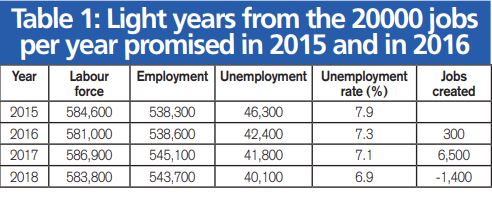Publicité
Unravelling the eccentricity: between Jugnauth’s rosy figures and Uteem’s sober facts
Par
Partager cet article
Unravelling the eccentricity: between Jugnauth’s rosy figures and Uteem’s sober facts

Falling unemployment does not always mean rising employment. Based on empirical evidence, the unemployment figure has become a completely irrelevant indicator of the health of the labour market and of the economy.
1.An economic riddle wrapped in a labour market mystery inside an unemployment enigma
Government is enthralled at the slump in the unemployment figures. The Prime Minister and Minister of Finance stated in the National Assembly on Tuesday 16th April that the 2018 unemployment rate of 6.9 % is the lowest for the last 17 years. Statistically, the statement is correct. However, from a job creation standpoint, the reality is very different as the acclaimed decrease in unemployment is not attributable at all to a rise in employment as the number of people with a job has decreased by 1,400 from 545,100 in 2017 to 543,700 in 2018. We need to disentangle this fascinating paradox as it is a real economic headscratcher. It proves that falling unemployment does not always mean rising employment. The predicament is worst than a jobless expansion as it was a “jobloss” growth in 2018. Reza Uteem challenged the figures and pointed out that youth unemployment is very high and has increased in the fourth quarter of 2018 compared to the corresponding quarter of 2017. This is factually accurate as reflected in the official figures released by Statistics Mauritius recently. Based on empirical evidence, it is plain that the unemployment figure has become a completely irrelevant indicator of the health of the labour market and of the economy.
2.Forgotten but unfulfilled promise of high job creation

Job creation is the area where many promises were made. Yet delivery is abysmal. In its 2015-2019 programme of January 2015, Government stated that “some 15,000 jobs will be created annually”
In the “second economic miracle” speech of August 2015, it was forcefully claimed that “100,000 new direct and indirect jobs will be created within the coming five years (20,000 per annum)”.
And in the 2016-2017 budget, it was pompously announced that “some 21,400 youths, men and women will be taken out of unemployment”.
Even if one allows for the reckless populism of this rhetorical undertaking, the gap between promises and achievement is yawning.
Table 1 shows the labour force, employment and unemployment trend since 2015.

i) Only an insignificant 300 net jobs were generated in 2016 as employment rose from 538,300 in 2015 to 538,600 in 2016;
ii) There were 6,500 more net jobs in 2017 with employment rising from 538,600 in 2016 to 545,100 in 2017;
iii) 1,400 net jobs were destroyed in 2018 with a decline in employment from 545,100 in 2017 to 543,700 in 2018;
iv) An annual average of 1,800 net jobs were created in 2016, 2017 and 2018. It represents an awful delivery of 9% compared to the target of 20,000 aimed by Government;
v) The only reason why unemployment has fallen from 41,800 in 2017 to 40,100 in 2018 is a decrease of 3,100 in the labour force from 586,900 in 2017 to 583,800 in 2018. Many people are being removed from the ACTUAL labour force and classified as “POTENTIAL” labour force;
vi) Had the labour force stayed constant in 2018 at 586,900, the number of persons unemployed would have risen to 43,200 (instead of 40,100) while the rate of unemployment would be 7.4% (instead of 6.9%);
vii) 5,800 persons were artificially excluded from the unemployment figure in 2017 even if they were ALL unemployed and either available for or looking for a job. However, as they were deemed not to be both available and looking for a job at the same time, they were not counted as being jobless even if they were unemployed;
viii) In addition to the rate of unemployment at 7.1% (around 41,800 persons) in 2017 and the exclusion of 5,800 from the labour force, there was considerable slack in the job market with high labour underutilisation by 117,700 persons who were in employment but still available for extra work. It means that out of a labour force of 586,900 in 2017, around 165,300 (comprising of 41,800 officially unemployed plus 5,800 artificially excluded from unemployment cohort plus 117,700 underemployed persons) are either not utilised at all or underutilised. It constitutes a sizeable 28% of the labour force.
3. It’s the labour market stupid
When we speak of the unemployment rate declining, we usually think of a situation where an unemployed person gets a job and moves from unemployment to employment. The ranks of the unemployed would decline while the number of people in employment would rise. The best outcome from a socio-economic standpoint is for unemployment to decline while employment grows. But the unemployment rate could come down in another way. An unemployed worker could be removed from the labour force, reducing the size of both the number of officially unemployed workers and the labour force. This seemingly contradictory result produces a lower unemployment rate with job losses. Exactly what has happened in 2018.
When one closely examines the labour market data between 2015 and 2018, one finds a completely different picture from the rosy one painted by Government. It is important to understand two very simple equations in labour economics to fully grasp what is unfolding.
i) Population aged 16 and plus = labour force + Economically inactive people
ii) Labour force = employment + unemployment. The population aged 16 and over comprises those who are in the labour force and those economically inactive. And the labour force is made up of those in employment and persons who are unemployed. The unemployment rate is obtained by dividing the unemployment figure into the labour force. Far from the lower unemployment rate being a cause for a good cheer, it could point to a disturbing new trend in the labour market when all three statistics are on a downward trajectory.
The labour force fell by 3,100 from 586,900 in 2017 to 583,800 in 2018. Employment declined by 1,400 from 545,100 in 2017 to 543,700 in 2018. As a result, unemployment decreased statistically by 1700 from 41800 in 2017 to 40,100 in 2018.
More specifically the equation is as follows:
Decrease in labour force (3,100) = decline in employment (1,400) + fall in unemployment (1,700).
Sadly, unemployment is not lower because unemployed people are finding jobs but rather as a result of 3,100 people being removed from the labour force. It is a mechanical and not an economic reduction in the rate of unemployment.
4. Beware of euphoric celebration
Normally, lower unemployment is good news. But this time, unemployment actually fell for a bad reason. It is a worrying sign for the economy as there are simply not enough jobs being created. Worse 1,400 jobs disappeared in 2018. The policy blunder would be to assume that a fall in the unemployment rate necessarily implies a rise in employment and that net job creation is positive. There is need for caution against effusive zeal and concentrating only on the mechanical decline in the unemployment statistics without an informed understanding of labour market dynamics. Failure to comprehend such economic nuances may lead to profound disillusionment in the employment strategy. Economists know fully well that falling unemployment in itself is no guarantee that enough net jobs are being created to fulfill the legitimate aspirations of those seeking gainful employment. It is the fundamental reason why many countries have a greater focus on job creation than on the rate of unemployment on a stand alone basis.
There are other disturbing trends in the labour market. We have one of the lowest activity rates among upper middle income countries. The activity rate which measures the share of the working age population in the labour force is low and falling. It is significantly lower for women at only 46%. A lower activity rate leads to a smaller labour force which is bad for future economic growth. Youth unemployment remains very high at almost 25%. It means that 1 in 4 of our youth is unemployed. The female youth joblessness rate was a staggering 32% in 2017. There is also a fall in the employment to working age population ratio, which is a better measure of the job situation. It confirms the stagnation in the employment market.
5.Concluding Remarks
Simply relying on the unemployment rate as an indicator of the health of the job market masks underlying problems. In a nutshell, a fall in unemployment that leads to rising employment is a good outcome while a decline in joblessness accompanied by significant job destruction is a poor result. In 2018, the unemployment rate fell because 3,100 people were removed from the labour force. And 1,400 jobs were destroyed. Gainful employment generation is key to reversing this downward spiral. It is high time we focus on net job creation and not get distracted by a mechanical fall in the unemployment rate. Especially as the average number of net jobs generated per year was a piffling 1,800 in 2016, 2017 and 2018, which is light years from the 20,000 promised.
Hardly a cause for celebration. Reza Uteem is right to lift the veil and sound the alarm.
Publicité
Publicité
Les plus récents






